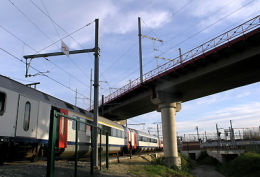Posted 29th March 2011 | 3 Comments
Rail to dominate inland transport market by 2050

AN AMBITIOUS plan to boost rail’s share of the transport market by 2050, cutting carbon emissions, has been unveiled by the European Commission.
The Commission wants to cut carbon emissions by 60 per cent, and in its new plan, called Transport 2050, the Commission said it had drawn up a ‘roadmap for a competitive transport sector that increases mobility and cuts emissions. We can and we must do both. The widely held belief that you need to cut mobility to fight climate change is simply not true. Competitive transport systems are vital for Europe's ability to compete in the world, for economic growth, job creation and for everyday quality of life’.
Vice president Siim Kallas, who is responsible for transport, added that ‘curbing mobility is not an option, neither is business as usual’. He went on: “We can break the transport system's dependence on oil without sacrificing its efficiency and compromising mobility. It can be win–win.”
The intention is to create a ‘Single European Transport Area’ with more competition and fully integrated transport, spelt out as 40 separate initiatives.
Different goals have been set for different types of journey – within cities, between cities, and long distance.
Within cities, 50 per cent of all medium-distance passenger and freight transport should shift from road to rail and water. By 2050, the majority of medium-distance passenger transport, involving journeys of 300km or more, should be by rail.
By 2030, 30 per cent of road freight travelling more than 300km should shift to other modes such as rail or water, and more than 50 per cent by 2050.
The plan also calls for a move towards full application of ‘user pays’ and ‘polluter pays’ principles. The private sector will be widely involved, with the intention of eliminating ‘distortions’, generating revenues and financing more investment in transport.
For long-distance travel and intercontinental freight, the Commission expects that aviation and ships will continue to dominate. New engines, fuels and traffic management systems will increase efficiency and reduce emissions.
For urban transport, it wants a move to cleaner cars and cleaner fuels, seeking a 50 per cent shift away from conventionally fuelled cars by 2030, phasing them out in cities by 2050.
One result will be that the movement of goods in major urban areas will be essentially CO2-free by 2030. By 2050, road transport fatalities should be almost eliminated.
Reader Comments:
Views expressed in submitted comments are that of the author, and not necessarily shared by Railnews.

Sam Green, Bournemouth, uk
I dont see how.There isnt the capacity.Goods yards lifted and houses built on them,Goods loops lifted ,routes closed since the 1960s.It would take a huge effort and lots of money.I dont think there is the will to do it.Especially when the amount in £s in mentioned!
Geraint Griffiths, Chester, England
I'd love to see how this would be implemented...
H Harvey, Birmingham
Absolutely great
BUT
at the same time they are promoting 60ft 60t lorries
Left hand and right hand!!!!
get a letter into your UK MP and MEP NOW